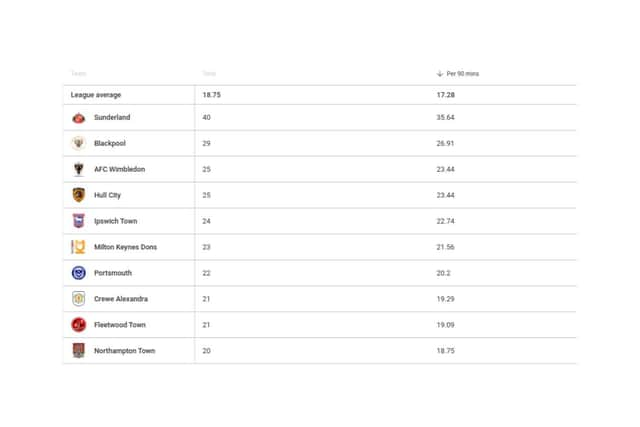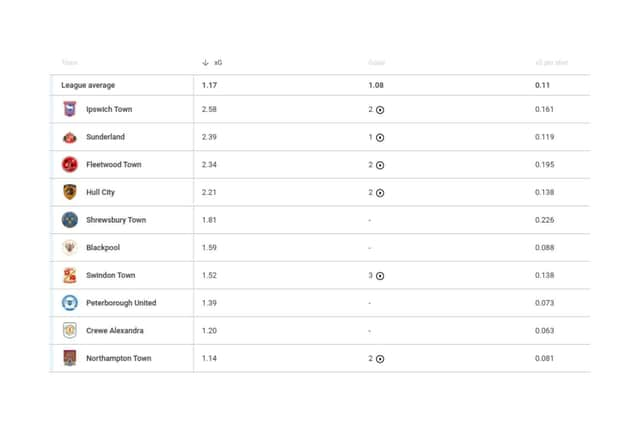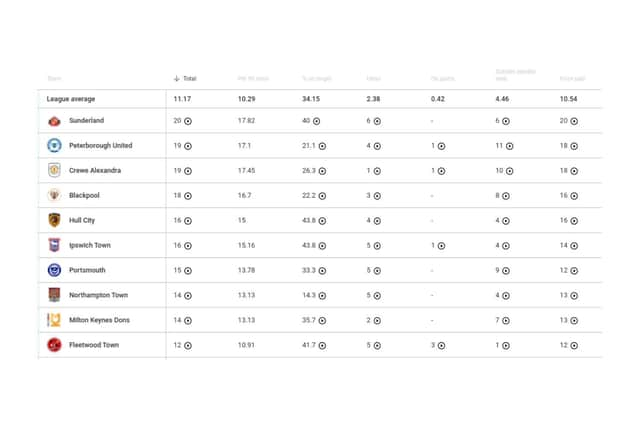The numbers behind Sunderland's opening-day frustration assessed in detail and what they tell us explored
and live on Freeview channel 276
Karl Robinson's side were beaten play-off finalists last year and despite a disappointing opening-day defeat to Lincoln City, they are expected by most to challenge again.
Phil Parkinson's side then welcome Peterborough United, before travelling to Charlton Athletic at the beginning of October.
Advertisement
Hide AdAdvertisement
Hide AdLittle wonder, then, that last weekend's 1-1 draw with Bristol Rovers was met with frustration.


Sunderland left themselves with much work to do after conceding a sloppy early penalty, handing the visitors something to try and hold onto.
It was a frustrating first-half performance from the Black Cats, who rallied to rescue a late equaliser and were denied three points only by some excellent stops from Rovers' goalkeeper Anssi Jaakkola.
But what do the statistics tell us about Sunderland's performance and where they go next?
Advertisement
Hide AdAdvertisement
Hide AdWe put the game under the microscope of the Wyscout database for a closer look...


The attacking numbers
It was a contest that Sunderland would have expected to take three points from, even if Bristol Rovers have invested well over the course of the summer.
We would also expect the Black Cats to have produced a significant attacking output over the course of the game, given that Rovers were increasingly happy to sit on their lead.
Nevertheless, it's worth noting just how much dominance Sunderland enjoyed in the game.
Advertisement
Hide AdAdvertisement
Hide Ad

They enjoyed 65.2% of the ball over the course of the 90 minuted, a tally better only by MK Dons in their draw away at Doncaster Rovers.
Sunderland had the mosts shots throughout the division's opening round of fixtures (20, with Peterborough United and Crewe Alexandra on 19), and they also had by some distance the most touches inside the opposition box. Their total on that metric was 40, 11 ahead of the next-best team, which was Neil Critchley's Blackpool.
Blackpool were also the only team in the division to complete more passes throughout the contest (though they were beaten by Ryan Lowe's Plymouth Argyle at Home Park).
Sunderland attempted 40 crosses over the 90 minutes, an extraordinary tally that reflected their territorial dominance in the second half in particular.
Advertisement
Hide AdAdvertisement
Hide Ad

Interestingly, it was also the most crosses that the team have managed since Parkinson took charge in October last year.
Nor were those efforts entirely wasted. It was Denver Hume's persistence that finaly led to the first goal, and the team's overall success rate of 37.5% with those crosses was an increase on their average for 2020 (30.6%).
These attacking numbers, unsurprisingly, meant that Sunderland produced one of the best expected goals outcomes for the division on the opening weekend.
Their XG tally of 2.39 was bettered only by Ipswich Town, who produced a tally of 2.58 in their 2-0 win over crisis-hit Wigan Athletic.
Advertisement
Hide AdAdvertisement
Hide AdIt highlights the fact that Sunderland's main issue against Bristol Rovers was not in getting to the final third. The issue was in their finishing, and Parkinson also rued the fact that his side did not produce their second-half dominance in the opening exchanges.
All the indications in the later stages were that Rovers would have struggled to hold on.


One other key concern for the Black Ctas, particularly as it has been a long-standing issue in Parkinson's tenure, is that this dominance did not lead to numerous chances for Will Grigg.
Grigg did not have a shot during the game, and there were few moments when he received the kind of service he needs from team-mates.
Advertisement
Hide AdAdvertisement
Hide AdThere was an overhit pass from Chris Maguire in the first half when he was waiting in space, and one excellent pass from Max Power that was notable because there were so few others.
Parkinson has work to do to get the best out of his attacking assets.
Any other business?
One of the key frustrations for many supporters after Saturday's game was that Sunderland appeared to have reverted a more long-ball game than they had during pre-season.
The stats show that Sunderland were certainly not afraid to go direct.
Advertisement
Hide AdAdvertisement
Hide AdTheir tally of 71 long passes was exceeded only by Accrington Stanley; with Portsmouth third having played 70.
Sunderland's total was a slight increase ob both their total against Hull City and their 2020 average, though their pass rate in total was also in excess of both.
Any conclusions?
Sunderand, without doubt, were fortunate even depsite their dominance.
Brandon Hanlan showed that their defence can struggle against pace in the final third, and Bailey Wright ought to have been shown a second yellow card early in the second half for a foul on the striker.
Advertisement
Hide AdAdvertisement
Hide AdBristol Rovers boss Ben Garner rightly pointed out that it was mainly after that point that Sunderland began to take total control of the contest.
Still, Rovers had just four shots throughout the contest. Only Plymouth managed fewer. While their XG total was lifted by their penalty, their XG-per-shot was 0.24, the lowest in the division.
Tougher challenges await for Sunderland and Parkinson himself conceded that composure and quality in the final third is going to be the key moving forward.
"The main thing today was not being clinical enough with that final pass, the quality of the cross or the finish," Parkinson said.
Advertisement
Hide AdAdvertisement
Hide Ad"It was a combination of us not showing enough quality in those areas, and the opposition defending well and the goalkeeper producing one fantastic save in particular.
"Irrespective of the shape of the team, it’s about when we get in those areas, can we produce? I'm certain we can."
The stats would suggest his assessment was a fair one, though supporters will also rightly point out that these are issues we have seen Sunderland struggle with before.
To that end, they will want to see improvement in the stern tests ahead.
